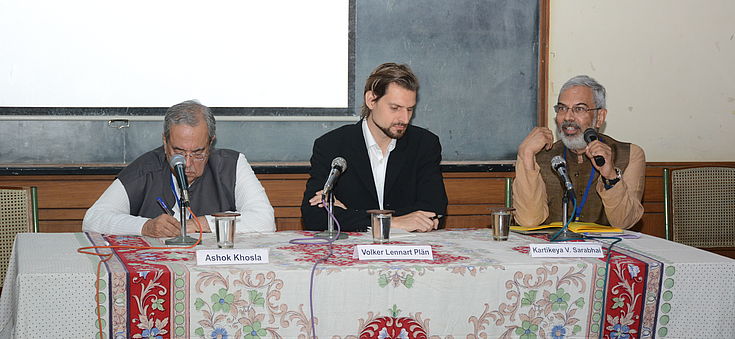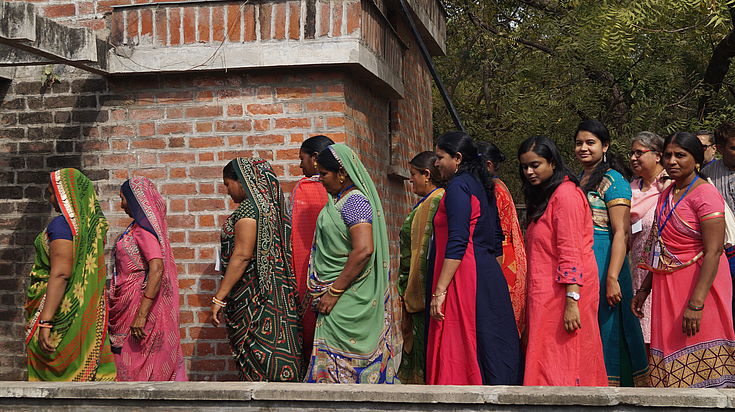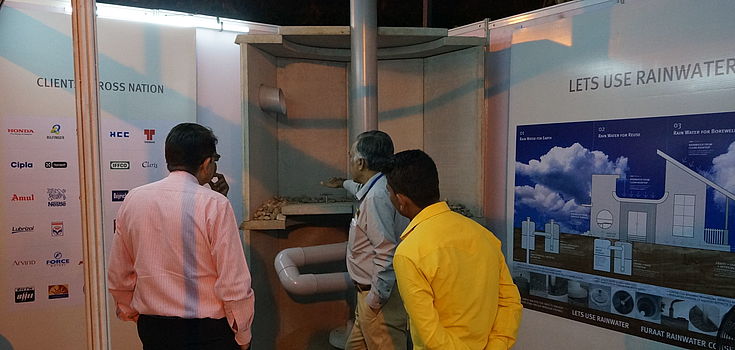National Jal Setu Conference brings in expertise from all over India
Water – Gujarat’s biggest problem

Inaugural address by Kartikeya V. Sarabhai, Volker L. Plän and Ashok Khosla
The National Conference on “Addressing gaps in achieving Rural Water Security: An integrated approach” was organized by Centre for Environment Education (CEE) in partnership with Hanns Seidel Foundation (HSF) in Ahmedabad at CEE main campus. It was part of the HSF-CEE project called “Jalsetu – Empowering Women Elected Representatives for Water Governance and Climate Change”. The aim of the conference was to explore how rural water security in the face of climate change can be addressed through integrating learnings from science, technology, community practices and through empowering communities to manage their water resources, strengthening governance processes which are more informed, gender-sensitive, and use existing government programmes and schemes. To this end, the conference succeeded in bringing together different stakeholders ranging from government officials, policy makers, academicians and researchers, implementers and people from institutions of governance, to share their concerns and discuss learnings and best practices.
The two-day conference spanned various topics which were addressed in six panels:
Panel 1: Understanding rural water security in the context of climate change
Panel 2: Science and innovation for addressing rural water security
Panel 3: Managing rural water resources: Role of planning participation
Panel 4: CSR Initiatives in the Water Sector – Learnings, Challenges & Needs
Panel 5: Presentations on Case Studies for Sustainable water management especially in the context of climate change: CSOs
Panel 6: Rural water security: Way forward
This conference turned out to be appropriate place to discuss the existing practices in rural water security. The participants were mainly practitioners from the ground, sharing their practical solutions for managing water resources, corporate social responsibility (CSR) initiatives as well as science and innovation for addressing rural water security. For CEE and HSS it facilitated a platform to share the setup and learnings from the Jal Setu project for future replication within Gujarat and in other Indian states. A group of Elected Women Representatives (EWRs), who were both participants and beneficiaries of Jal Setu, shared their experiences of the implementation and impact of Jal Setu project in their areas. Throughout the conference they contributed with brief insights from their villages on the topics discussed during the respective panel.

Elected Women Representatives walking towards the conference room
It was striking that all speakers except one were men, while the EWRs just added brief insights from their perspectives. This is in line with Professor Ahmed’s observation, pointing out a lack in women water professionals or policy-makers once you go up the governance level. By listening to the panellists, the audience got familiar with several approaches and solutions implemented in rural areas. Pictures, videos, samples and data were presented to get the message across. One example is the construction of rainwater storage tanks using natural fibres such as coconut coir and banana fibre.
The panel discussion on “CSR Initiatives in the Water Sector – Learnings, Challenges & Needs” gave a whole new light to the future of water-related development cooperation. As per the Companies Act 2013 of the Indian government, a CSR company “shall ensure that the company spends, in every financial year, at least two per cent of the average net profits of the company made during the three immediately preceding financial years, in pursuance of its Corporate Social Responsibility Policy”.1 Currently, a number of NGOs are operating with the help of CSR funding. However, there is a growing trend that the companies are launching their own organizations for CSR spending, which means less fund availability for the NGOs from the CSR fund. It was recommended that CSR fund should be invested in long-term development rather than short-term development; and should support the risk-taking ability of farmers. While posing a threat to non-profit altruistic, scientific-driven approaches by Civil Society-Organisations, the 2013 act could ensure sustainable investment into the water sector, which is crucial for both people and companies. When CSR projects are well-planned and implemented correctly, they can act as catalysts for great socio-economic change.
One common message of the conference was the need for local-level solutions to address the growing water problems in the wake of climate change. Educating and involving the concerned communities for example in preparing water budgets is a prerequisite to achieve sustainable improvement and further develop local water resources. Locally developed plans, which are owned by people, can then be presented to the authorities in order to receive support for the implementation. It is also noteworthy that climate change adaptation measures such as capacity building is a lengthy process, where years are required to see the results. So is the fact that community members need to perceive the impact of climate change to become active in the first place. The same is the case with water pollution: Communities should be made aware about the qualities of water that they drink. In his opening speech at the inaugural session of the conference, the director of CEE Mr. Sarabhai told a story from his own experience about a village where people suffered from fluorosis in water and from the age of 40, they were unable to get up from bed. Therefore, they used a rope around their upper body to pull themselves up in the morning. When they were asked about their problem, in the first place they would not regard it as a problem, since everybody had a rope and they already considered it as normal.

An exhibitor explains his product to conference participants
The inaugural, the first and the last panel were held in English, while the rest of the conference tool place in either Hindi or Gujarati. Many English contributions were however summarised for the EWRs right after each talk. In a meeting between CEE and HSS directly after the conference, the possibility of using smartphones with translating apps was discussed. One interpreter could simultaneously interpret the speech into her/his devise, while the group of attendees, which does not understand the language of the respective presentation, can use their smartphones to listen to it. Apparently, the technical requirements were not present at that time and therefore the idea of using smartphones was postponed to a future occasion.
Part of the conference was a small water technology exhibition, which functioned as a platform for local businesses and organizations to promote their products and solutions with regards to water security and water management. The fair continued during the second day of the conference, which provided external visitors also the chance to pay a visit.
The event underlined the effective cooperation between CEE and HSF. The Jal Setu project started in 2016 in two districts; its findings are now widely distributed and being adapted by other organisations. Likewise, the conference offered massive opportunities for cross-exchange between NGOs, politics, research and even politics.
1 Section 135, Companies Act, 2013

